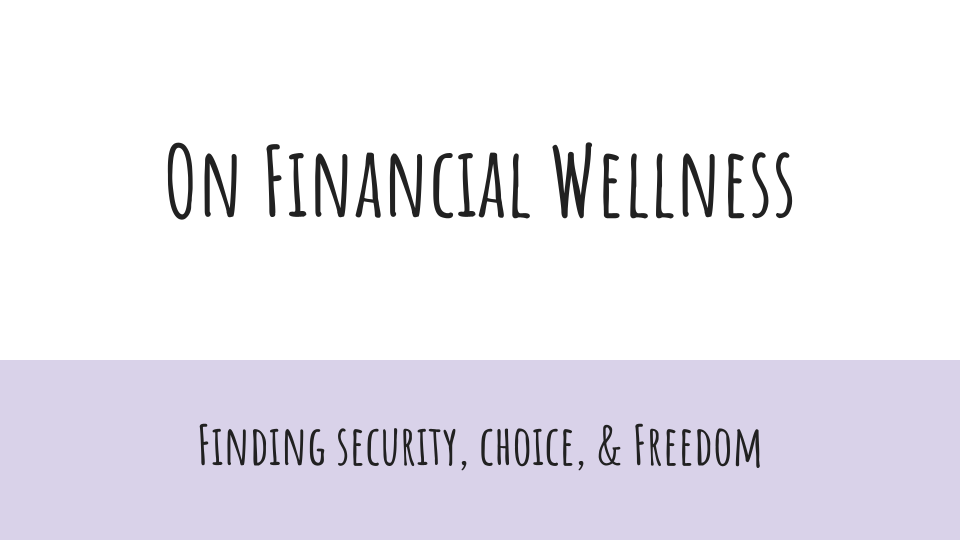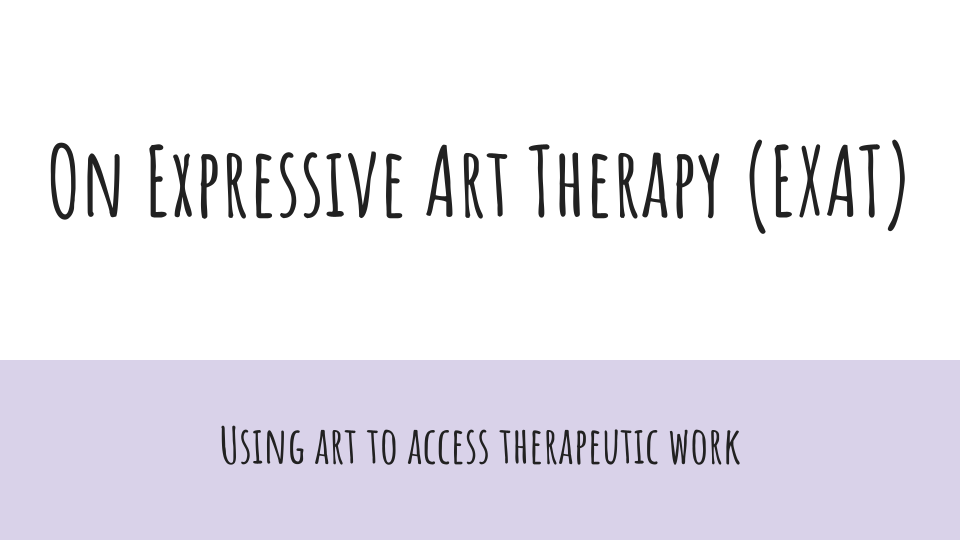On Holistic Wellness
Holistic Wellness is the integration of your: Physical, Mental, Emotional, and Spiritual selves. When you feel congruent across these four quadrants, you feel at peace, healthy, and present to your current environment. In this chapter we explore self-care strategies, as well as ways to evaluate how you are attending to each of these four ‘Parts of Self.’
Remember - you get to define spirituality for yourself! In this classroom spirituality is defined as feelings of connection or disconnection.
Below you will find resources related to Holistic Wellness.
More about Holistic Wellness
Holistic Wellness is the integration of your own self-care into values-aligned behaviors. It comprises four ‘quadrants’ of self: Physical, Emotional, Mental, and Spiritual.
Physical Wellness: Imagine a 3-legged stool. This is your physical wellness stool. Everyone has one, including you. The three legs of the stool are
Sleep
Nutrition
Exercise
Our society today has a lot of information about how to sleep, how to eat, and how to exercise. Throw all that out the window and say: I get to decide what is healthiest for me. Everyone requires different sleep, different nutrition, and different exercise. The point here is to explore what best works for you. In general, 6-8 hours of sleep, moderate amounts of exercise, and a reasonable nutritional input yield a robust sense of physical wellness.
Emotional Wellness: How do you carry emotions in your body? They are always there, ebbing and flowing with any given environmental stimulus. Emotional wellness dictates an ability to:
Recognize the body cue (i.e. - where are you feeling emotion in your body)
Identify the emotion (i.e. - chest is tight, might be anxiety)
Figure out when you started feeling this way (i.e. - when I saw my ex at the grocery store)
Choose a response (i.e. - I am going to breathe for 1-minute in the chips aisle)
When you allow yourself to feel emotions, they will pass in 30 seconds to 3 minutes. When you ignore the emotions or distract from them (by using substances or watching TV or exercising for 4 hours), they will become trapped in your body and emerge chronically with greater intensity.
The goal is to cleanse your body of these emotions by honoring how you feel, when you feel it, and allowing yourself the space to move through it.
Mental Wellness: What are your thoughts at any given time? How do you speak to yourself at any given time? Most people are (1) thinking about the future or the past, and (2) treating themselves cruelly. Something interesting - you only spend about 50% of your time focused on the present moment. This is why mindfulness is so important. It brings us back to what is real. A mindfulness practice will allow you to:
Focus on the present moment.
Notice your self-talk.
Choose another way of speaking to yourself, or how your mind is speaking about others.
This is an integrative practice. That means that it is easier be mentally well when your emotions are lower, you feel in spiritual connectivity, and are in a sense of physical health.
Spiritual Wellness: I think of this as a sense of connection or of disconnection. What do you feel connected to, or maybe disconnected from? For some, that can take the form of religion. For others, nature. For others, community. Spiritual wellness is cultivating a sense of connection that feels:
Empowering
Energy-giving
Supportive
Spirituality is a resource you can turn to and lean on. Ways to grow your sense of spiritual wellness include:
Gratitude practice
Meditation & mindfulness
Intentional time in nature / community / etc. (the key here is intentional)
So, what do I do from here?
Think about ways you would like to grow and/or shift your holistic wellness. Maybe whip out your journal and spend some time writing about each quadrant for yourself. Bring your thoughts to our sessions together and we can come up with a plan that feels right for you. Again, your journey is unique and not prescriptive. I look forward to hearing what you come up with and how I can best assist you.
Holistic Wellness Suggested Activities
Take time this week to consider the following activities related to exploring Holistic Wellness. There are several different options for you to explore in case one modality works better for you. Please note that your Conversation Prompts can also make great Journal Topics.
Journal Topics
Think about your ‘Physical Wellness.’ Journal about your experiences with healthy sleep, exercise, and nutrition. Remember that your needs are unique and that you are allowed to have a different definition of health than our society. If there are things you want to shift about your sleep, exercise, and/or nutrition, discuss ways you could begin to create a more supportive structure.
Take time to consider the emotions you feel in your body. Journal about these emotions - where do you feel them? What are your body’s cues that let you know you are experiencing this emotion? What object does this emotion remind me of? For example, ‘I feel anxiety in my chest as a tightness & shortness of breath. It feels like a corded rope stretched tight and fraying.’ See if you can compile a whole list of emotions and related bodily cues.
What do you notice about your thought patterns? What is it like to be in your head? Do you find yourself thinking about something(s) more than others? What helps you let go of those repetitive or ruminating thoughts?
What are some ways that you distract yourself from your thoughts and emotions? How has this served you in the past? How would you like to be more intentional about letting go of these thoughts and emotions in the future?
What is your relationship with the word ‘Spirituality?’ What does this word mean to you now? What would you like it to mean to you in the future, if anything at all?
What do you feel most connected to? What is it about these things, places, or people that help you feel so connected?
What do you feel disconnected from? What leads to you feeling disconnected? How can you start to shift towards more connection?
Conversation Prompts
With a partner, friend, or family member, discuss your definition of holistic wellness as it pertains to your life. Remember that you are allowed to create your own definition of wellness!
Explore ways that you have been influenced to ‘fit’ into society’s definition of wellness, and how this has affected you.
Discuss your goals for holistic wellness and ways you can support each other in reaching these goals in the short and long term.
Experiential & Artistic Activities
Make a physical representation of your ‘physical wellness stool.’ Consider different scenarios where your sleep, exercise, or nutrition is unbalanced. Notice what that does to the stability of your stool.
Draw an outline of your body (either life-sized or smaller scale). Assign different colors to be different emotions, and then map out where these emotions live within you. Notice how they interact with each other.
Create a piece of art honoring your ‘spiritual self,’ whatever that means to you. Begin the process with the intention of feeling connected to yourself during this experience. Notice times when you begin to feel disconnected from the experience and consider what led to that sense of disconnection.
Additional Resources on Holistic Wellness
Documents/Books on Holistic Wellness
You Can Heal Your Life, by Louise Hay
Clearing Emotional Clutter, by Donald Altman
The Mindfulness-Based Emotional Balance Workbook, by Cullen, Pons, & Kabat-Zinn
Healing Emotions, by the Dali Lama & Daniel Goleman
The Stress-Proof Brain, by Melanie Greenberg
Full Catastrophe Living, by Jon Kabat-Zinn
Other Chapters in WELLNESS
Check out the Rest of the Classroom!
References
Bishop, S. R., Lau, M., Shapiro, S., Carlson, L., Anderson, N. D., Carmody, J., Segal, Z. V., Abbey, S., Speca, M., Velting, D., & Devins, G. (2004). Mindfulness: A proposed operational definition. Clinical Psychology: Science and Practice, 11(3), 230–241. https://doi-org.proxy006.nclive.org/10.1093/clipsy.bph077
Doucleff, M. (2013, December 30). Mapping emotions on the body: Love makes us warm all over. NPR. Retrieved January 8, 2022, from https://www.npr.org/sections/health-shots/2013/12/30/258313116/mapping-emotions-on-the-body-love-makes-us-warm-all-over
Goleman, D. (2003). Healing emotions : conversations with the Dalai Lama on mindfulness, emotions, and health. Shambhala.
Miller, G. (2020). Integrating substance abuse and pain management into counseling approaches: Counselors can create a safe place for clients to speak openly as they try to navigate the complicated landscape of their struggles with substance use and pain management issues. Counseling Today, 63(5), 50–54.
Ohrt, J. H., Clarke, P. B., & Conley, A. H. (2019). Wellness counseling : a holistic approach to prevention and intervention. American Counseling Association.
Thomas, B. (2019). Creative Coping Skills for Teens and Tweens : Activities for Self Care and Emotional Support Including Art, Yoga, and Mindfulness. Jessica Kingsley Publishers.
Thornton, L. (2013). Whole person caring : an interprofessional model for healing and wellness. Sigma Theta Tau International.
















